Frank Sinatra. The name itself evokes images of smoky nightclubs, suave sophistication, and a voice that could melt hearts. Known as “Ol’ Blue Eyes” and “The Voice,” Sinatra wasn’t just a singer; he was a cultural icon. His songs are cornerstones of the Great American Songbook, transcending generations and musical genres. While his impact as a Hollywood actor is undeniable, it was his profound influence on jazz and popular music that cemented his legendary status. For many, Frank Sinatra serves as an accessible entry point into the world of jazz, bridging the gap for listeners who might otherwise hesitate to explore the genre. His charisma and distinctive persona have ensured his enduring appeal, long after his passing on May 14, 1998. Born Francis Albert Sinatra on December 12, 1915, his career spanned an incredible 54 years, leaving behind a treasure trove of recordings.
But with such an extensive discography, where do you begin? What are the quintessential Frank Sinatra tracks that defined his career and continue to resonate with audiences today?
This article delves into 25 of the Best Frank Sinatra Songs, showcasing the iconic recordings that propelled him to superstardom and maintained his position as a musical giant throughout his career and beyond. From ballads to swing anthems, and even holiday classics, this list offers a comprehensive exploration of Sinatra’s most beloved work.
If you’re a jazz enthusiast or aspire to play the timeless songs of Frank Sinatra, consider exploring resources that can enhance your musical journey. While this article celebrates his recorded legacy, further musical exploration can deepen your appreciation and understanding.
Francis Albert Sinatra: More Than Just a Voice
.jpg)
Francis Albert Sinatra, affectionately known as Ol’ Blue Eyes or Chairman of the Board, was an American singer and actor who navigated and shaped a transformative era in music and entertainment. A multiple Grammy Award winner, Sinatra’s influence extends far beyond the realm of music.
While we categorize Frank Sinatra as a jazz singer today, he occupied a unique space as a pop superstar who also starred in films and mingled with influential figures, including Presidents Franklin D. Roosevelt and John F. Kennedy. He wasn’t just celebrated for his artistic talents; he embodied the style, attitude, and aspirations of 1950s America.
Sinatra’s musical journey began in 1939 when he joined the Harry James Orchestra. His talent quickly shone, leading him to collaborations with musical luminaries such as Tommy Dorsey, Count Basie, Duke Ellington, Ella Fitzgerald, and Antônio Carlos Jobim, amongst many others.
The 1940s witnessed the phenomenon of Sinatramania, a cultural frenzy that predated Beatlemania and the fervor surrounding K-Pop. Sinatra captivated a new generation of teenage girls, often called “Bobby Soxers” due to their distinctive fashion style. Major record labels eagerly sought to sign him, and he soon transitioned into musicals and movies, becoming a central figure in American pop culture.
Throughout his career, Sinatra experienced periods of both triumph and adversity, navigating slumps and resurgences with unwavering dedication. He consistently recorded and refined his sound, evolving his musical style across the decades, leaving an indelible mark on the landscape of 20th-century music.
25 Essential Frank Sinatra Songs: A Journey Through His Discography
Let’s embark on a journey through the best Frank Sinatra songs, exploring key recordings from his remarkable discography. This curated list, while not ranked in order of preference, highlights 25 timeless classics that encompass his diverse repertoire, from festive Christmas tunes to memorable movie soundtrack hits.
Given Sinatra’s prolific output of over 1,400 recorded songs and 59 solo studio albums, this list represents just a fraction of his immense contribution to music. If your personal favorite isn’t immediately apparent, be sure to check out the honorable mentions section at the end – it might be featured there!
Let’s delve into the songs that truly define the Sinatra legacy.
1. Fly Me To The Moon
“Fly Me To The Moon,” a song that has become synonymous with romance and aspiration, was penned in 1954 by songwriter Bart Howard. While numerous artists recorded versions of this song in the years following its release, it was Frank Sinatra’s rendition that propelled it to iconic status. His version, released on the 1964 album It Might As Well Be Swing, recorded with the Count Basie Orchestra, is arguably the definitive interpretation.
This album itself is a treasure trove of classic Sinatra tracks, with several others appearing on this very list. The arrangement for “Fly Me To The Moon” was crafted by the legendary Quincy Jones, who notably shifted the song’s time signature from 3/4 to 4/4, injecting it with a stronger swing feel at Sinatra’s request.
Interestingly, in 1968, as the Apollo program propelled humanity towards the moon, Frank Sinatra’s swinging version of “Fly Me To The Moon” became an unofficial anthem for the lunar missions, further cementing its place in popular culture and its association with dreams and reaching for the stars.
Listen to Frank Sinatra’s timeless version of “Fly Me To The Moon”:
2. In The Wee Small Hours Of The Morning
“In The Wee Small Hours Of The Morning,” a poignant ballad exploring themes of loneliness and lost love, was composed by David Mann with lyrics by Bob Hilliard. This classic Frank Sinatra song graced his 1955 album In The Wee Small Hours, a landmark release often considered one of the first true concept albums in popular music.
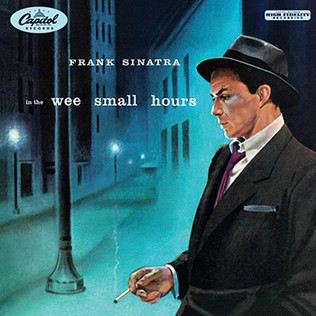 In The Wee Small Hours album cover
In The Wee Small Hours album cover
The album delves into the emotional landscape of longing, unrequited love, and the aftermath of failed relationships. The title track, “In The Wee Small Hours Of The Morning,” perfectly encapsulates the album’s mood of romantic melancholy and vulnerability.
While many jazz and pop singers have since recorded “In The Wee Small Hours Of The Morning,” none have quite captured the raw emotion and nuanced delivery of Sinatra’s original. His performance remains the benchmark for interpreting this deeply personal and evocative song.
Experience Frank Sinatra’s original recording of “In The Wee Small Hours Of The Morning”:
3. My Funny Valentine
“My Funny Valentine,” a tender and enduring show tune, was written by the iconic duo of Richard Rodgers and Lorenz Hart for their 1937 musical Babes in Arms. By the time Frank Sinatra recorded it in 1953, it was already a beloved standard in the American popular music canon.
Sinatra’s rendition of “My Funny Valentine” appeared on his seventh studio album, Songs For Young Lovers, released in 1954 by Capitol Records. This album marked the beginning of a fruitful and long-lasting musical partnership between Frank Sinatra and conductor Nelson Riddle, a collaboration that would span over two decades and produce some of Sinatra’s most iconic recordings.
Frank Sinatra’s interpretation of “My Funny Valentine” is characterized by its sensitivity and understated emotion, highlighting the song’s inherent tenderness and vulnerability.
Listen to Frank Sinatra’s classic rendition of “My Funny Valentine”:
4. Somethin’ Stupid
“Somethin’ Stupid,” a charming and lighthearted duet, took a slightly different path to Sinatra’s discography. Originally a folk song written and recorded by C. Carson Parks with his wife, Gaile Foote, in 1966, it was Frank Sinatra and his daughter, Nancy Sinatra, who transformed it into a global phenomenon.
Their 1967 duet version of “Somethin’ Stupid” was released as a single and soared to the #1 spot on the Billboard Hot 100 chart for four weeks, becoming a massive pop hit. It later featured on Frank Sinatra’s album The World We Knew (1967).
Stylistically, “Somethin’ Stupid” represents a departure from the classic swing and crooning style of Sinatra’s earlier work. It leans more towards soft pop and easy-listening balladry, demonstrating Sinatra’s remarkable ability to adapt and remain relevant across evolving musical landscapes and appeal to diverse audiences.
Enjoy Frank and Nancy Sinatra’s delightful performance of “Somethin’ Stupid”:
5. The Christmas Waltz
Frank Sinatra’s appeal extended beyond romantic ballads and swing tunes; he also became deeply associated with the holiday season. “The Christmas Waltz” is a prime example of his festive contributions and stands as one of the most beloved Christmas songs in his repertoire.
Written specifically for Sinatra in 1954 by the songwriting duo Sammy Cahn and Jule Styne, “The Christmas Waltz” initially appeared on the album White Christmas that same year. However, it’s the 1957 version, featured on his iconic Christmas album A Jolly Christmas From Frank Sinatra, arranged by Nelson Riddle, that has become the definitive recording.
A Jolly Christmas From Frank Sinatra is a cornerstone of holiday music, appearing multiple times on this list, and is brimming with nostalgic Christmas cheer. “The Christmas Waltz,” with its unique 3/4 time signature and warm, comforting melody, perfectly captures the magic of the season.
Listen to this iconic Frank Sinatra Christmas song, “The Christmas Waltz”:
6. Autumn Leaves
“Autumn Leaves” is undeniably one of the most recognized and beloved jazz standards of all time. Its melancholic beauty and timeless melody have made it one of the most recorded jazz songs in history. Frank Sinatra’s vocal interpretation is widely considered one of the most iconic versions of this tune.
Originating as the 1945 French song “Les Feuilles Mortes” by Joseph Kosma, it received an English lyric makeover in 1950 by Johnny Mercer, who rechristened it “Autumn Leaves.” Since then, it has been covered countless times by artists across genres.
Frank Sinatra’s rendition of “Autumn Leaves” appeared on his 1957 album Where Are You?, an album dedicated entirely to ballads. This release contrasted sharply with his previous album, A Swinging Affair (1957), which primarily featured upbeat swing numbers, showcasing Sinatra’s versatility and mastery of different moods and styles.
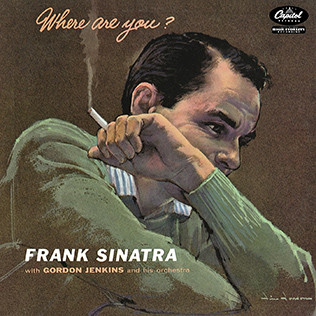 Where Are You album cover
Where Are You album cover
Listen to Frank Sinatra’s evocative version of “Autumn Leaves”:
7. My Way
“My Way” is perhaps the quintessential Frank Sinatra anthem, embodying his signature bravado, independence, and self-assuredness. Released as a single in 1969, the song is a powerful reflection on life choices, personal journeys, and the unwavering commitment to living life on one’s own terms.
The lyrics tell the story of a person looking back on their life’s path, acknowledging both triumphs and setbacks, and ultimately concluding that they navigated it all by doing things “my way.” It’s widely interpreted as a metaphorical reflection of Sinatra’s own career and personal philosophy.
While the melody is adapted from the French song “Comme d’habitude” composed by Jacques Revaux, the English lyrics were specifically written with Frank Sinatra in mind. He recorded it and transformed it into a signature song that defined a significant part of his later career. “My Way” has been covered by numerous artists, including Elvis Presley and Sid Vicious, but Sinatra’s version remains the definitive and most iconic.
Experience Frank Sinatra’s powerful rendition of “My Way”:
8. The Way You Look Tonight
“The Way You Look Tonight” is a timeless classic originating from the 1936 film Swing Time. With music by Jerome Kern and lyrics by Dorothy Fields, it’s a quintessential example of the enduring beauty of the American Songbook.
Countless singers have recorded this standard over the decades, but Frank Sinatra’s version stands out as particularly iconic and enduringly popular. It’s a testament to his ability to take a well-loved song and make it his own, elevating it to new heights.
Sinatra’s recording of “The Way You Look Tonight” was released on his 1964 album Sinatra Sings Days of Wine and Roses, Moon River, and Other Academy Award Winners, which, as the title suggests, features several other award-winning songs, including more entries on this list.
Listen to Frank Sinatra’s definitive version of “The Way You Look Tonight”:
9. The Girl From Ipanema
“Garota De Ipanema,” known in English as “The Girl From Ipanema,” is a cornerstone of the Bossa Nova genre and an emblem of the cool, sophisticated sound and atmosphere of the Bossa Nova movement. Bossa Nova gained significant popularity in the United States in the 1960s, becoming a beloved subgenre of jazz, solidifying “The Girl From Ipanema” as a cherished jazz standard.
Composed by Antônio Carlos Jobim with original Portuguese lyrics by Vinícius de Moraes, the song later received English lyrics by Norman Gimbel, broadening its international appeal.
While numerous versions exist, Frank Sinatra’s rendition is particularly noteworthy because it’s a duet with the song’s composer, Antônio Carlos Jobim. Jobim sings his verses in the original Portuguese, adding an authentic and intimate dimension to the recording. This iconic duet appeared on their collaborative 1967 album Francis Albert Sinatra & Antônio Carlos Jobim, a landmark album bridging American and Brazilian musical traditions.
Experience this iconic duo perform “The Girl From Ipanema”:
10. Let It Snow! Let It Snow! Let it Snow!
Another essential Christmas classic on our list is “Let It Snow! Let It Snow! Let It Snow!” This festive favorite was composed in 1945 by Jule Styne with lyrics by Sammy Cahn, quickly becoming a holiday staple.
Frank Sinatra’s version of “Let It Snow! Let It Snow! Let It Snow!” was initially released as a single in 1950. It features backing vocals and harmonies by the B. Swanson Quartet, renowned for their Christmas song arrangements, adding a warm, vintage holiday feel to the recording.
“Let It Snow” was later included in a 1957 re-release of Sinatra’s 1948 album Christmas Songs by Sinatra by Columbia Records. This re-packaged version was titled Christmas Dreaming and also featured the title track “Christmas Dreaming (A Little Early This Year),” further solidifying its holiday appeal.
Listen to Frank Sinatra leading the B. Swanson Quartet in this classic version of “Let It Snow!”:
11. Misty
“Misty,” a quintessential romantic ballad, began its life as an instrumental piece written in 1954 for jazz pianist Erroll Garner. Later, Johnny Burke added lyrics, transforming it into a vocal standard that became a favorite of jazz singers.
Frank Sinatra was among the many vocalists who embraced “Misty,” recording his version for his iconic orchestral ballad album Sinatra and Strings, released in January 1962. Sinatra’s rendition of “Misty” is lush, romantic, and features the rich, sweeping orchestral arrangements that became a signature sound of his mid-career recordings. The song’s dreamy melody and heartfelt lyrics perfectly complement Sinatra’s emotive vocal delivery and the opulent orchestral backdrop.
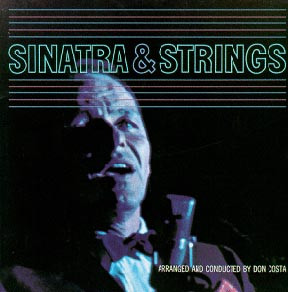 Sinatra and Strings album cover
Sinatra and Strings album cover
Listen to Frank Sinatra’s timeless rendition of “Misty”:
12. I Thought About You
“I Thought About You” is an enduring American classic dating back to 1939. Composed by Jimmy Van Heusen with lyrics by Johnny Mercer, it’s a song that captures the bittersweet pang of longing and remembrance.
Frank Sinatra’s interpretation of this jazz standard first appeared on his 1956 album Songs for Swingin’ Lovers!, an album that perfectly embodies the swinging, upbeat style that defined a significant part of his career. This version of “I Thought About You” is classic Sinatra, showcasing his effortless phrasing and engaging personality. The entire Songs for Swingin’ Lovers! album features vibrant, poppy arrangements of classic American songbook tunes, masterfully arranged by Nelson Riddle.
Songs for Swingin’ Lovers! offered a stylistic contrast to Sinatra’s previous album, In The Wee Small Hours (1955), which explored more introspective and traditional ballads. “I Thought About You,” in its swinging arrangement, highlights Sinatra’s versatility and ability to excel in both ballad and up-tempo settings.
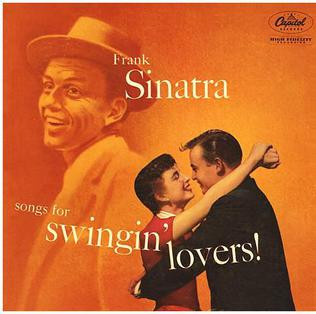 Songs for Swingin' Lovers album cover
Songs for Swingin' Lovers album cover
Listen to Frank Sinatra’s swinging performance of “I Thought About You”:
13. Have Yourself A Merry Little Christmas
“Have Yourself A Merry Little Christmas” is an undisputed American Christmas classic, and Frank Sinatra’s version is consistently ranked among the top Christmas songs of all time. Originally written by Hugh Martin and Ralph Blane in 1943, it was initially a more melancholic song.
Judy Garland first introduced the song in the 1944 musical Meet Me in St. Louis, with revised, more optimistic lyrics. While Garland’s version became a Christmas hit, it was Frank Sinatra’s 1957 rendition that truly propelled the song into the stratosphere of holiday classics.
Sinatra’s version, featured on the 1957 album A Jolly Christmas From Frank Sinatra, further modified the lyrics to be even more positive and uplifting, aligning with his optimistic persona and solidifying the song’s place as a Christmas staple for generations to come.
While undoubtedly familiar, listen to Frank Sinatra’s iconic version of “Have Yourself A Merry Little Christmas”:
14. It Was A Very Good Year
“It Was A Very Good Year,” a reflective and nostalgic ballad, was written in 1961 by Ervin Drake. However, it was Frank Sinatra’s 1966 rendition that transformed it into a widely recognized and deeply moving song.
Sinatra’s version, released as a single, earned him a Grammy Award for Best Male Vocal Performance and became his first #1 hit in the Adult Contemporary category, demonstrating his continued relevance and appeal in a changing musical landscape. The song’s lyrics evoke a poignant sense of looking back on different periods of life, represented by different “years,” each associated with distinct memories and emotions.
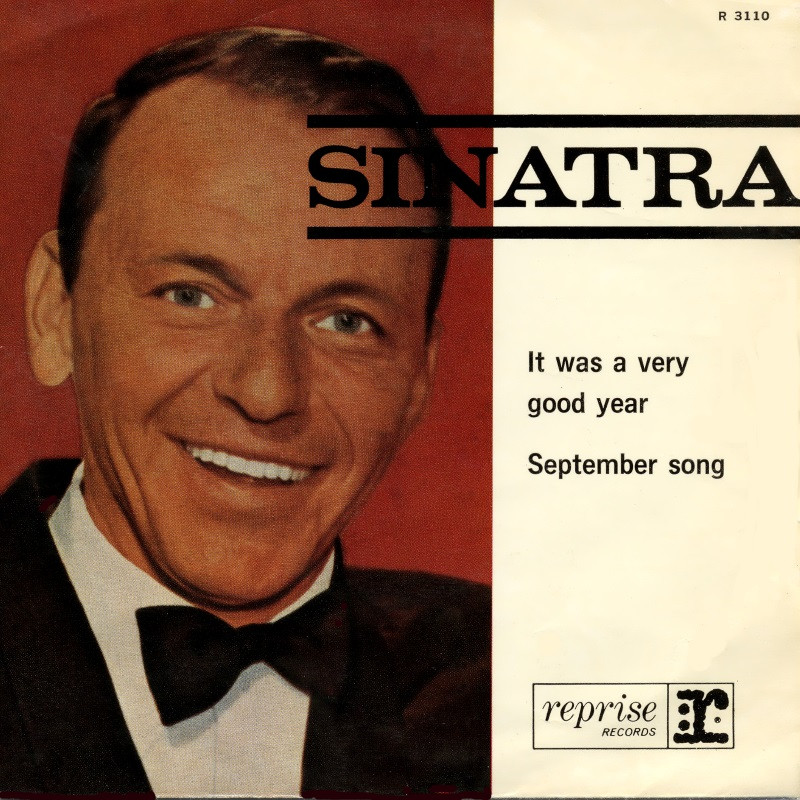 It Was A Very Good Year single cover
It Was A Very Good Year single cover
Experience Frank Sinatra’s Grammy-winning performance of “It Was A Very Good Year”:
15. Three Coins In The Fountain
“Three Coins In The Fountain,” a charming and romantic tune, was composed by Jule Styne with lyrics by Sammy Cahn. It was written for the 1954 romantic comedy film of the same name, Three Coins in the Fountain. Frank Sinatra recorded the song for the film’s soundtrack, lending his signature voice to this cinematic love song.
Sinatra’s version of “Three Coins In The Fountain” went on to win the Academy Award for Best Original Song the following year, further cementing its place in popular culture and highlighting Sinatra’s successful crossover into film and soundtrack work. The song’s optimistic melody and lyrics capture the hopeful spirit of romance and the allure of making wishes at iconic landmarks.
/media/File:Three_Coins_in_theFountain(poster_art).jpg)
Listen to Frank Sinatra’s Oscar-winning rendition of “Three Coins In The Fountain”:
16. Come Fly With Me
“Come Fly With Me” is an instantly recognizable Frank Sinatra signature song and one of the first titles that often comes to mind when people think of his greatest hits. It was a frequent and beloved inclusion in his live performances, embodying his charismatic stage presence and adventurous spirit.
The music for “Come Fly With Me” was specifically written for Frank Sinatra by Jimmy Van Heusen, and the lyrics were penned by Sammy Cahn. The song served as the title track for Sinatra’s 1958 album of the same name, Come Fly With Me, an album that further explored themes of travel, romance, and escapism. As a quintessential piece of American nostalgia, “Come Fly With Me” has been featured in numerous film soundtracks over the years, reinforcing its timeless appeal and association with a sense of adventure and sophistication.
Listen to Frank Sinatra’s invitation to “Come Fly With Me”:
17. New York, New York
“New York, New York” is a powerful anthem that has become inextricably linked with Frank Sinatra, though it was originally written for the 1977 Martin Scorsese film New York, New York. The original recording featured Liza Minnelli, who also starred in the movie, and her version was a hit in its own right.
However, it was Frank Sinatra who truly cemented “New York, New York”‘s iconic status when he covered it on his 1980 album Trilogy: Past Present Future. Sinatra’s rendition resonated deeply with audiences and became a staple of his live performances, often serving as a rousing finale. The song’s themes of ambition, resilience, and the allure of the big city perfectly aligned with Sinatra’s persona and the image of New York as a center of dreams and opportunity.
Listen to Frank Sinatra’s signature version of “New York, New York”:
18. Summer Wind
“Summer Wind” has an interesting origin story, beginning as a 1965 German pop tune titled “Der Sommerwind,” written by Heinz Meier and Hans Bradtke. Recognizing its catchy melody and potential for international appeal, English lyrics were soon written, allowing American artists to embrace this infectious pop song.
Frank Sinatra recorded his version of “Summer Wind” in 1966, and it was featured on his album Strangers in the Night. Sonically, Sinatra’s recording is notable for its big band arrangement that includes an organ, adding a distinct pop flavor to the classic big band sound. “Summer Wind” became a hit for Sinatra, reaching number one on the Easy Listening charts and number 25 on the Billboard Hot 100, demonstrating his continued ability to connect with contemporary audiences.
Listen to Frank Sinatra’s breezy rendition of “Summer Wind”:
19. Santa Claus Is Comin’ to Town
“Santa Claus Is Comin’ to Town” is another beloved and nostalgic Christmas classic, written in 1934 by J. Fred Coots and Haven Gillespie. It’s one of the most frequently recorded Christmas songs, with a remarkably diverse range of artists, from Bruce Springsteen to Michael Bublé and The Jackson 5, having created their own interpretations.
Frank Sinatra’s version of “Santa Claus Is Comin’ to Town” was released in 1948 on his album Christmas Songs by Sinatra. His rendition captures the joyful anticipation and childlike wonder associated with Christmas, delivered with his signature warmth and charm.
Listen to Frank Sinatra’s festive take on “Santa Claus Is Comin’ to Town”:
20. I Get A Kick Out Of You
“I Get A Kick Out Of You” is a classic Cole Porter composition, written for the 1934 Broadway musical Anything Goes. Frank Sinatra recorded two distinct versions of this song, showcasing its enduring appeal and his evolving musical style.
His first version was recorded in 1953, during the pre-code Hollywood era, before stricter censorship regulations were enforced in popular entertainment. The original lyrics contained a drug reference that was later altered after the Hays Code came into effect.
Sinatra’s second version, recorded in 1962 and featured on the album Sinatra and Swingin’ Brass, incorporated the amended lyrics, reflecting the changing social and censorship landscape. Both versions, however, capture the song’s playful energy and Sinatra’s dynamic vocal delivery.
 Sinatra and Swingin' Brass album cover
Sinatra and Swingin' Brass album cover
Listen to Frank Sinatra singing the energetic “I Get A Kick Out Of You”:
21. The Brooklyn Bridge
“The Brooklyn Bridge” holds a special place in Sinatra’s discography as it originates from the 1947 American romantic comedy film It Happened in Brooklyn, in which he also starred. Columbia Records released the recording as a single in 1947, capitalizing on Sinatra’s dual appeal as both a singer and a screen idol.
This recording highlights the strong connection between Frank Sinatra’s singing career and his acting endeavors. His persona as a celebrated American singer was deeply intertwined with his Hollywood career, a common phenomenon in the early days of cinema when musicals were a dominant form of entertainment. “The Brooklyn Bridge” song itself is a charming and sentimental ode to New York City and romantic encounters.
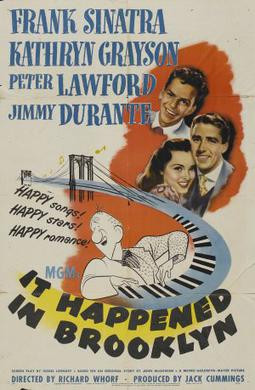 It Happened in Brooklyn film poster
It Happened in Brooklyn film poster
Listen to Frank Sinatra’s performance of “The Brooklyn Bridge”:
22. All The Way
“All The Way” is a quintessential pop ballad from the 1957 film The Joker Is Wild, a movie in which Frank Sinatra starred in a lead role, further showcasing his cinematic presence and musical contributions to film.
Written by the successful songwriting team of Jimmy Van Heusen (music) and Sammy Cahn (lyrics), “All The Way” was one of two songs Sinatra recorded for The Joker Is Wild. Both “All The Way” and “Chicago (That Toddlin’ Town)” were released as singles in 1957 by Capitol Records, further promoting both the film and Sinatra’s musical output.
“All The Way” is another prime example of Sinatra’s widespread appeal, transcending genres and mediums. The song’s heartfelt lyrics and melodic beauty, combined with Sinatra’s emotive delivery, made it an instant classic.
Experience Frank Sinatra singing “All The Way”:
23. The Best Is Yet To Come
“The Best Is Yet To Come” holds a unique significance in Frank Sinatra’s legacy. Originally written for Tony Bennett by Cy Coleman and Carolyn Leigh in 1959, it became indelibly associated with Sinatra when he recorded it for his 1964 album It Might as Well Be Swing, recorded with the legendary Count Basie and his Orchestra.
It Might as Well Be Swing is considered a landmark album in Sinatra’s career, and “The Best Is Yet To Come” became one of its standout tracks. Remarkably, “The Best Is Yet To Come” was the last song Frank Sinatra ever performed publicly before his death, adding a poignant layer to its already powerful message of optimism and hope. The words “The Best Is Yet To Come” are even engraved on his tombstone, solidifying its place as a personal and professional motto for Sinatra.
Listen to Frank Sinatra’s iconic rendition of “The Best Is Yet To Come”:
24. You Make Me Feel So Young
“You Make Me Feel So Young” is a classic pop tune that radiates youthful energy and exuberance. Composed by Josef Myrow with lyrics by Mack Gordon in 1946, it was originally written for the Hollywood musical Three Little Girls in Blue, released the same year.
Frank Sinatra recorded “You Make Me Feel So Young” in 1956 for his album Songs For Swinging Lovers!, perfectly capturing the song’s upbeat and joyful spirit. Sinatra’s version proved to be so timeless and universally appealing that it was featured in the 2003 Christmas film Elf, introducing it to new generations of listeners.
Listen to Frank Sinatra’s eternally youthful performance of “You Make Me Feel So Young”:
25. I Got The World On A String
Finally, we arrive at a personal favorite! “I Got The World On A String” is included as a testament to the author’s individual appreciation and to highlight another facet of Sinatra’s vast repertoire. Written in 1932 by Harold Arlen and Ted Koehler, it was already a well-established American classic by the time Frank Sinatra recorded it in 1953.
Sinatra’s rendition of “I Got The World On A String” is often cited as a definitive example of a “Frank Sinatra song,” showcasing his signature style and vocal charisma. It features a stunning orchestral arrangement conducted by Nelson Riddle, adding layers of richness and sophistication to the already vibrant tune. Sinatra’s delivery is brimming with the optimism and carefree attitude that are often associated with swing-era pop tunes, making it an irresistible and uplifting listening experience.
Listen to Frank Sinatra’s captivating version of “I Got The World On A String”:
Honorable Mentions: More Sinatra Gems
Narrowing down Frank Sinatra’s extensive discography to just 25 songs is a challenging task! To further celebrate his immense contribution to music, here’s a list of honorable mentions, featuring more fantastic songs from his incredible career. Perhaps you’ll find some of your personal favorites here:
- “Nancy (with the Laughing Face)” (1944)
- “Strangers In The Night” (1966)
- “Night and Day” (1962)
- “Baubles, Bangles, and Beads” (1959)
- “One For My Baby (And One More For The Road)” (1964)
- “Five Hundred Guys” (1956)
- “Only The Lonely” (1958)
- “Can I Steal A Little Love” (1957)
- “I’ll Follow My Secret Heart” (1962)
- “Moon River” (1964)
- “O Little Town Of Bethlehem” (1957)
- “The Right Girl For Me” (1949)
- “It’s The Same Old Dream” (1958)
- “She’s Funny That Way” (1947)
- “All Of Me” (1948)
- “Silent Night, Holy Night” (1957)
- “Lean Baby” (1953)
- “I’ve Got You Under My Skin” (1956)
- “Jingle Bells” (1948)
- “High Hopes” (1961)
- “If I Had Three Wishes” (1955)
- “It’s A Wonderful World” (1961)
- “White Christmas” (1954)
- “None But The Lonely Heart” (1950)
- “Hello Young Lovers” (1965)
- “(She’s Funny That Way) I Got A Woman Crazy For Me” (1947)
- “That Old Black Magic” (1946)
- “Strange Music” (1962)
- “Indian Summer” (1968)
- “Wave” (1971)
This expanded list further demonstrates the depth and breadth of Frank Sinatra’s musical artistry and the enduring appeal of his vast catalog of songs.
